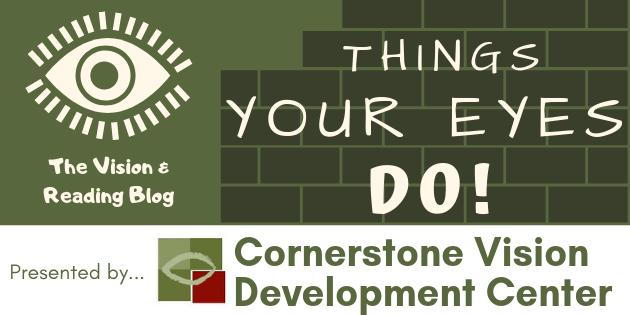
Hey, everyone! Shannon Gerber here with Cornerstone Vision Development Center (CVDC).
Per way of introduction, I’m a vision therapist, a gardener, an avid hiker, and a total geek. Well, at least when it comes to my job; I’m rather addicted to helping children (and adults!) improve their lives through vision therapy.
Yeah, it’s a pretty awesome gig. But here’s the hard part: (Well, besides making phone calls. I’m sorry if you’ve had to talk with me via that device: it’s awkward central.)
...
But the real hard part is having such powerful tools and practices at our disposal but knowing that many people don’t know about what we get to do!
So we’ve decided at CVDC to help clear the air. This newsletter/ blog/ journal/ [insert your best synonym here] is our attempt to let you in on our *unintentional* secret.
My piece of this endeavor is to offer some insight (pun intended) into what CVDC’s doctors and therapists are testing and training as well as why we try to go above and beyond your typical eye exam. Our focus here is on visual skills. Or, as I like to say, “the things your eyes DO!”
...
“What?” You may say. “Things your eyes do? …Isn’t good eyesight something you’ve either got or not?”
And you’d be partially right. But eyesight is one piece of your visual system. Relying on eyesight—or 20/20 acuity—alone to determine you have “perfect vision” is like saying the only thing it takes to be a good runner is the right pair of shoes.[1]
Vision, like running, is dependent on so much more than the tools that get you started!
It’s not just about the structure, you see. Yes, the shape of an eye determines how it bends (refracts) light, and you can get lenses to do that work for you if you’re too nearsighted or farsighted… or after you’ve had, say, over 40-50 birthdays (hallelujah for bifocals).
And, yes, there are eye diseases like cataracts, glaucoma, or macular degeneration that stem from problems around that structure.
And YET! Just like you can train your legs to run faster and longer, your arms to lift more, and your fingers to type quicker (all things I am personally in need of training on), your eyes and the muscles that move and refocus them are actively controlled by your brain: and that means we can learn to train them to be more efficient at the things they do.
...
Visual skills are developed over time, like learning to ride a bike or play the piano. When they don’t develop typically, or if you have a hard time teaming your eyes at certain distances, they can hold you back.
Ironically, visual problems are not obvious to the naked eye, so here are a couple stats to bring them to light:
1 out of 4 children struggle with reading and learning unnecessarily because of undiagnosed vision problems.
~60% of problem learners have undiagnosed vision problems contributing to their difficulties.[2]
Many of these problems are missed (go undiagnosed) because a school screening alone is limited in its scope.
Do you know of anyone that gets headaches when they read? Eyestrain? Notices blurry vision at school or on the computer? Sees double or shadowed text? Has an eye turn (Strabismus) or a lazy eye (Amblyopia)? Skips or repeats lines when reading? Has poor eye-hand coordination?
These problems are all symptoms of someone lacking in efficient visual skills. (Check out more here: https://www.covd.org/page/Symptoms.)
Unlike poor acuities due to refractive errors, these things aren’t fixed by a pair of glasses or contacts. But that’s good news! Because— back to the bike analogy— once you train your brain to use your eyes efficiently, those skills stick with you!
...
I’m going to stop here for now. But here are your take-aways from this information byte:
Know it! Vision is more than 20/20.
Do it! Learn to ask others about their vision to identify hidden problems and encourage them to seek professional help.
It’s been fun! Thanks for letting me share my passionate, geeky side. Until next time!
~ The VT Geek
Shannon Gerber, Certified Optometric Vision Therapist
[2] Borsting E, Rouse M, Deland P, Hovett S, Kimura D, Park M, et al. Association of symptoms and convergence and accommodative insufficiency in school-age children. Optometry. 2003;74:25-34. http://www.ncbi.nlm.nih.gov/pubmed/12539890
Rouse M, Borsting E, Hyman L, Hussein M, Cotter S, Flynn M, et al. Frequency of convergence insufficiency among fifth and sixth graders. Optom Vis Sci. 1999;76:643-9. http://www.ncbi.nlm.nih.gov/pubmed/10498006
